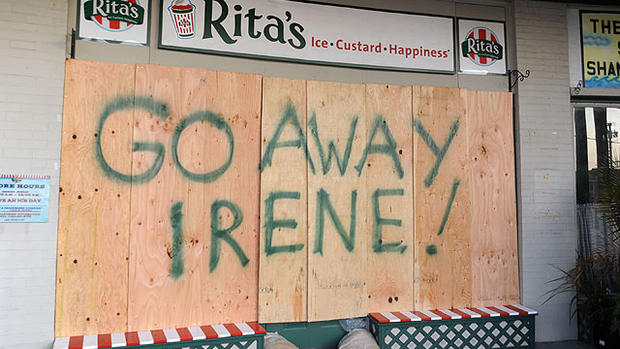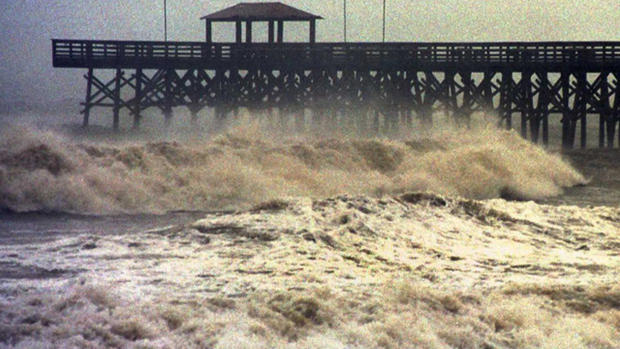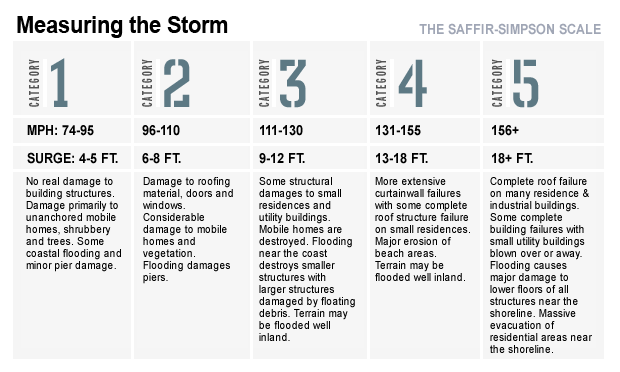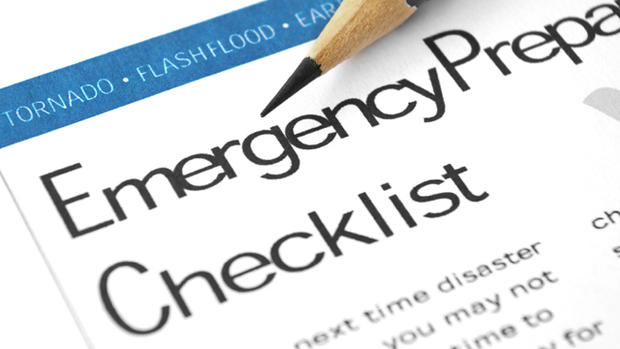Irene slams coast; Nearly 1M without power
Updated 6:35 p.m. ET
MOREHEAD CITY, N.C. - Hurricane Irene produced heavy rains and strong winds in North Carolina and Virginia late Saturday, after making landfall on the Outer Banks of North Carolina at dawn Saturday morning. So far, the storm has been blamed for at least 3 deaths, although reports on fatalities differ.
The massive storm lost some power after landfall but was still whipping up sustained winds of 80 mph, as it continued its run up the Eastern Seaboard. It still has a massive span of nearly 500 miles across.
As of 6:30 p.m. ET, the massive storm was nearing the North Carolina-Virginia border, just south of Virginia Beach, moving north-northeast at about 13 mph. CBS News meteorologist David Bernard reports that it is currently about 350 miles south-southwest of New York City, and is moving into the most densely-populated areas of the country.
New York City and the surrounding suburbs have shut down their public transportation systems in anticipation, and the area has descended into an eerie quiet as it awaits the storm.
The National Hurricane Center said the eye of the enormous Category 1 storm first made landfall over Cape Lookout, North Carolina, with winds of more than 115 mph.
Hurricane Irene live blogMajor developments:
- Paramedics in Nash County, N.C. say a man was killed outside his home by a tree limb blown down by Hurricane Irene. a driver in Pitt County perished when his car struck a tree on the side of a road Saturday morning. State Highway Patrol officials say they were investigating the fatal wreck and were not sure if it was storm-related. A falling tree limb killed a third man in Nash County, N.C. An 11-year-old boy died in Newport News, Va., after a tree fell on an apartment complex, reports CBS affiliate WTKR.
- Wind and rain have knocked out power to nearly 1 million customers in North Carolina and Virginia.
- New York City Mayor Michael Bloomberg warned New Yorkers that public transportation might not be available until late Monday afternoon. Power may also be cut in lower Manhattan due to lines being stored underground. Tropical storm winds and rain are expected to begin striking New York City beginning Saturday evening.
- More than 2 million people have been told to evacuate to safer places, and New York City ordered the nation's biggest subway system shut down for the first time because of a natural disaster.
- According to Red Cross spokesperson Kate Meier, more than 13,000 people stayed in nearly 150 Red Cross shelters across six states Friday night. More shelters are opening today.
- CBS News' Carter Yang reports that airlines have canceled 8,337 flights through Monday, and that number is expected to rise. N.Y.C. airports are shutting down for arrivals at noon Saturday, with last departures expected this evening at 10 p.m. Philadelphia's airport is shutting down tonight at 6 p.m. Circumstances at each airport will determine when flights will resume.
Hurricane Irene tracker
Irene: State-by-state look at dangers, prep
East Coast weathering Irene: Snapshots
At least 907,058 customers in North Carolina and Virginia are now without power. Progress Energy in N.C. reports 278,002 customers without electricity; 13,821 Duke Energy customers are affected; and in Virginia outages affect 615,235 Dominion Electric customers.
North Carolina Governor Beverly Perdue said rescuers and damage assessment teams are standing by as Hurricane Irene moves across the state.
Perdue said Saturday that hundreds of National Guard troops and Highway Patrol officers are standing by to help as needed, and Perdue said state officials are ready to do a damage assessment once the weather clears.
Perdue also said more than 80 shelters were available and more than 7,500 people used them overnight.
Two piers along North Carolina's southern Outer Banks have been damaged. Emerald Isle town manager Frank Rush says the end of Bogue Inlet Pier collapsed. In addition, part of the pier behind the Sheraton Hotel in Atlantic Beach has collapsed.
As the storm's outer bands of wind and rain lashed the North Carolina coast, knocking out power, authorities farther north begged people to get out of harm's way. Officials in the northeast, not used to tropical weather, feared it could wreak devastation.
"Don't wait. Don't delay," said President Obama, who decided to cut short his summer vacation by a day and return to Washington. "I cannot stress this highly enough: If you are in the projected path of this hurricane, you have to take precautions now."
Video: The urban hurricane
Video: Hurricane wreaks havoc on travel
New Jersey prepares for Irene
A coastal town official in North Carolina said witnesses believed a tornado spawned by Irene lifted the roof off the warehouse of a car dealership in Belhaven on Friday night and damaged a mobile home, an outbuilding and trees.
Forecasters said the core of Irene would pass near or over the North Carolina coast Saturday morning, roll along the mid-Atlantic coast Saturday night and move over southern New England on Sunday.
Hurricane warnings were issued from North Carolina to New York, and watches were posted farther north, on the islands of Nantucket and Martha's Vineyard off Massachusetts. Evacuation orders covered at least 2.3 million people, including 1 million in New Jersey, 315,000 in Maryland, 300,000 in North Carolina, 200,000 in Virginia and 100,000 in Delaware.
A tropical storm warning is in effect as far north as Fort Lawrence, Canada.
"This is probably the largest number of people that have been threatened by a single hurricane in the United States," said Jay Baker, a geography professor at Florida State University.
U.S. airlines canceled more than 9,000 flights through Monday, grounding hundreds of thousands of passengers as the storm could strike major airports from Washington to Boston.
New York City ordered more than 370,000 people who live in flood-prone areas to leave, including Battery Park City at the southern tip of Manhattan, Coney Island and the beachfront Rockaways. But it was not clear how many would do it, how they would get out or where they would go. Most New Yorkers don't have a car. Mayor Michael Bloomberg says 1,400 people are staying in shelters.
N.Y.C. mayor: Don't wait to evacuate
Generators, batteries big sellers ahead of Irene
Irene could cripple East Coast power supply
FEMA: Chance of Katrina-like flooding at coast
The New York City transit system carries about 5 million people on an average weekday, fewer on weekends. It has been shut down several times before, including during a transit workers' strike in 2005 and after the Sept. 11 attacks a decade ago, but never for weather.
Aviation officials said they had closed the five main New York City-area airports to arriving domestic and international flights as of noon on Saturday. Many departures also were canceled.
The airports are John F. Kennedy International, Newark Liberty International, LaGuardia, Stewart International and Teterboro.
Mayor Michael Bloomberg said there was little authorities could do to force people to leave and warned: "But if you don't follow this, people may die."
Shelters were opened Friday afternoon, and the city was placed under its first hurricane warning since 1985.
Defense Secretary Leon Panetta told 6,500 troops from all branches of the military to get ready to pitch in on relief work, and President Barack Obama visited the Federal Emergency Management Agency's command center in Washington and offered moral support.
"It's going to be a long 72 hours," he said, "and obviously a lot of families are going to be affected."
On Wall Street, sandbags were placed around subway grates near the East River because of fear of flooding. Tarps were placed over other grates. Construction stopped throughout the city, and workers at the site of the World Trade Center dismantled a crane and secured equipment.
The biggest New York utility, Consolidated Edison, considered cutting off power to 6,500 customers in lower Manhattan because it would make the eventual repairs easier. Mayor Michael Bloomberg also warned New Yorkers that elevators in public housing would be shut down, and elevators in some high-rises would quit working so people don't get trapped if the power goes out.
A day earlier, the city ordered evacuations for low-lying areas, including Battery Park City at the southern edge of Manhattan, Coney Island with its famous amusement park and the beachfront Rockaways in Queens.
New York has seen only a handful of hurricanes in the past 200 years. The Northeast is much more used to snowstorms - including the blizzard last December, when Bloomberg was criticized for a slow response.
For all the concern, there were early signs that the storm might not be as bad as feared. Some forecasts had it making landfall as a Category 3 storm and perhaps reaching New York as a Category 2.
Airlines said 9,000 flights were canceled, including 3,000 on Saturday. Airlines declined to say how many passengers would be affected, but it could easily be millions because so many flights make connections on the East Coast. There were more than 10,000 cancellations during the blizzard last winter.
American Airlines spokeswoman Andrea Huguely said it was not clear when flights would resume out of New York.
"The one thing about a hurricane is that you can prepare for it and you just have to adapt your plan based on how the storm travels," she said. "It's basically an educated guessing game."
The power losses were heavily concentrated in Virginia and North Carolina, where Irene charged ashore early Saturday morning.




